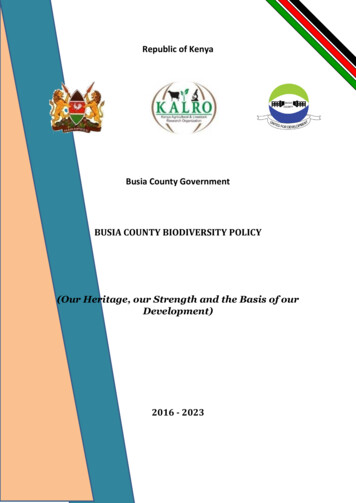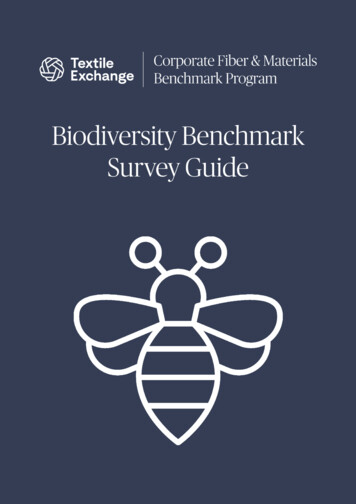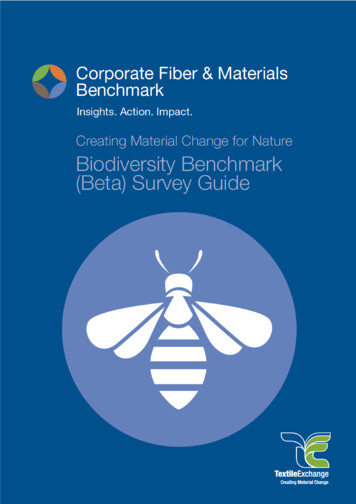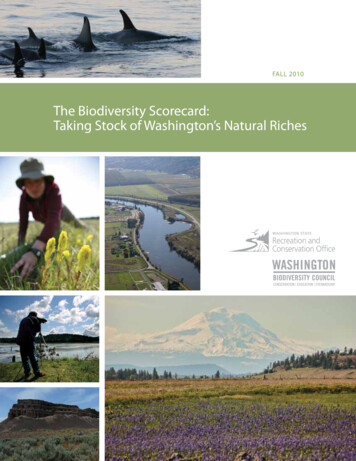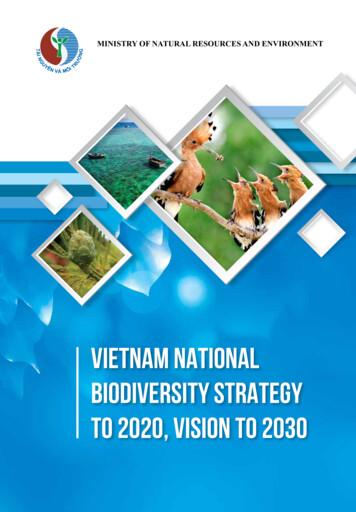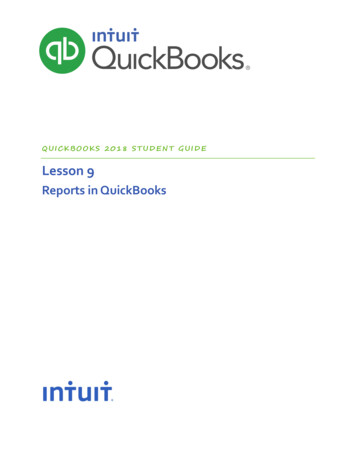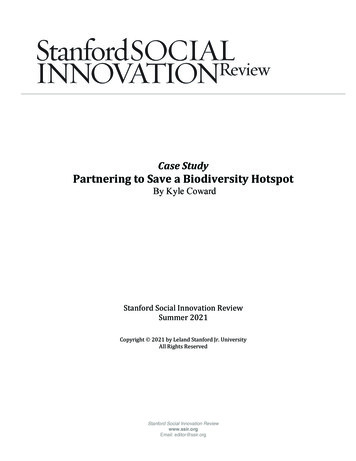
Transcription
Case StudyPartnering to Save a Biodiversity HotspotBy Kyle CowardStanford Social Innovation ReviewSummer 2021Copyright Ó 2021 by Leland Stanford Jr. UniversityAll Rights ReservedStanford Social Innovation Reviewwww.ssir.orgEmail: editor@ssir.org
Stanford Social Innovation Review / Summer 2021AN INSIDE LOOK AT ONE ORGANIZATIONPartnering to Save aBiodiversity HotspotAn American funding collaborative is on a mission to help environmental advocates in Southeast Asiaprotect the Mekong River. Can it do so while navigating the tide of regional politics?BY KYLE COWARDWhen it comes to areas of the world that are rich inboth natural beauty and complexity, SoutheastAsia provides a perfect snapshot.Stretching south of China down into archipelagos in the Pacific Ocean, it is a region oftropical and subtropical climates, where mountains of limestone karsts give way to coastal plains, and wherea large number of endemic species not found anywhere else inthe world call it home. Zero in on the continental mainland ofSoutheast Asia, and amid this lush, diverse region of mountains,plains, and forests is the mighty Mekong River.At more than 2,700 miles long and winding through six countries, the Mekong River is the longest river in Southeast Asia, the12th longest in the world, and possesses some of Earth’s richestbiodiversity, with more than 1,300 fish species, 1,200 bird species,and 20,000 plant species.The river’s economic impact on residents encompasses muchmore than tourism, as the river is home to the world’s largest inlandfreshwater fishery, which provides food security to millions of citizens. According to a joint report from the World Wildlife Fund(WWF) and global financial services giant HSBC, the Mekongregion’s growth rate in recent years has been estimated to be between5 and 8 percent, propelled by agricultural industries like fishing andrice production. Economies are especially prospering on the lowerbasin of the Mekong River, which is more navigable than the upperbasin due to a lesser concentration of sandbanks and rapids.The intergovernmental organization Mekong River Commissionhas placed the annual value of fisheries and fish farms in the lowerbasin at 17 billion; they make up more than 10 percent of the world’sfishing business. The region’s rice production is just as formidable, asit consists of around a quarter of the world’s rice exports. Nearly 65million residents live in the lower basin, and out of this flourishingeconomic activity, more citizens are flocking to urban areas.The river, which runs from China to Vietnam before emptyingout into the South China Sea, is heavily trafficked by cruise lines.Reporting on the Mekong River’s “booming” tourist industry in2019, CNBC noted that at least 10 ships had been slated to operatetours on the river in 2020, before the COVID-19 pandemic shuttered the industry.The rise of the lower Mekong’s urban population has graduallyaffected the land along the entire Mekong River region, from thePHOTO BY DENNIS SCHMELZ/ALAMY18
Stanford Social Innovation Review / Summer 2021PHOTO BY DENNIS SCHMELZ/ALAMY! A view of the Mekong River, wherethe Lower Mekong Funders Collaborativehas dedicated its efforts to environmental protection and restoration.upper to the lower basins. Throughout the Greater Mekong Subregion(GMS), consisting of China, Cambodia, Laos, Myanmar (Burma),Thailand, and Vietnam, urban areas have been growing by 3 to 5percent each year. By 2030, it is expected that more than 40 percentof residents will be living in and around GMS cities. Consequently,this growth has put a strain on natural resources along the lowerMekong River, particularly with the increased generation of hydroelectric power from dams. A similar situation is occurring in the lowerbasin, where annual energy demand growth is estimated at 7 percent.Having previously spent years living in Southeast Asia, Jack Tordoffis intimately aware about the region and knows quite well the tension there of balancing economic development with environmentaland ecological conservation. Tordoff is the managing director of theCritical Ecosystem Partnership Fund (CEPF), an Arlington, Virginiabased venture dedicated to worldwide biodiversity conservation, andhe has spent more than a decade working on behalf of sustainabilityconservation and development efforts in Southeast Asia.Dams play an important role in the economic developmentadvancement of nations by producing electricity, preventing floods,and providing crop irrigation in dry areas. Dams also impede thenatural flow of rivers and lead to alterations in habitats where fishfeed and breed. The alterations, in turn, can harm the life cycles offish and their ability to reproduce, consequently negatively affectingthe food supply for residents who rely on the river’s fish as an essentialstaple and a means of financial stability. This is the current situationof people who live along the Mekong River, where two major damscurrently operate and several are in the planning stages.“Once you play around with the availability of water, thereare implications for people who are most directly impacted,” saysTordoff. According to the World Health Organization, those implications include a loss of food security, negative water quality, andan increase in communicable diseases from species in the river.Additional ecological concerns in the region have arisen fromthe increased deforestation to make way for large-scale agroindustrial complexes, which are being built to meet the demand forcommodities like rice, along with rubber and palm oil. “On the onehand, you’re damming the river,” Tordoff says. “On the other hand,you’re clearing natural vegetation in the watershed.”A perfect storm of human-generated conditions such as climatechange and environmental degradation have made Southeast Asia19
Stanford Social Innovation Review / Summer 2021KYLE COWARD is a Chicago-based writerwho has contributed to The Root, ChicagoTribune, JET, Reuters, and The Atlantic. Aformer behavioral health counselor, he isa full-time reporter for the online tradepublication Behavioral Health Business.a prime candidate for the work of organizations like CEPF. Since2011, CEPF has partnered with a number of international philanthropic organizations to invest in solutions to environmental andecological issues in the lower Mekong. This partnership, known asthe Lower Mekong Funders Collaborative (LMFC), has providedeconomic support to more than 100 local civil society organizationsworking on biodiversity conservation projects and the promotionof economically sustainable development.“We’re trying to come up with models whereby protecting ecosystems, we can also deliver on the key development priorities forpeople, particularly food security and income,” says Tordoff.ESTABLISHING THE COLLABORATIVEThe LMFC comprises several grantmaking organizations that in addition to CEPF include the Margaret A. Cargill Philanthropies (MACP),the Chino Cienega Foundation, and the McConnell Foundation. Beneficiaries of the collaborative’s largesse include nongovernmental organizations (NGOs), community groups, and people’s movements thathave initiated projects of their own in the lower Mekong.“With all of the development that has taken place and the degradation that has happened, it’s a critically important freshwatersystem,” says Shelley Shreffler, an environment program officer atMargaret A. Cargill Philanthropies. “I think it’s important that wesupport communities and people in the region.”The lower Mekong basin—in which lie Cambodia, Laos, Myanmar,Thailand, and Vietnam—has been a focus of grantmaking efforts byvarious American funders since the late 1980s. That interest in thearea came at a time when Vietnam was attempting to normalizerelations with the United States after decades of regional conflict,and it increased in the mid-1990s, around the time that diplomaticrelations between the two countries were established.Tordoff notes that those initial undertakings were driven by international aid organizations from outside the region. Despite good intentions, Tordoff suggests, some of those early funding initiatives usedmore of a top-down approach that did not always take into accountthe input of local stakeholders. “The first real effort to improveenvironmental quality began in the late 1980s into the 1990s,” saysTordoff, who spent over a decade working in biodiversity conservationin Southeast Asia before joining CEPF in 2009. “Not that they werenot effective, but they were very externally driven.”Before the formation of the LMFC, its member organizationswere already pursuing biodiversity and sustainable developmentprojects independently in Southeast Asia. Knowledgeable of eachother’s work in the region, the organizations figured there wasstrength in numbers by pooling together their various researchefforts, resources, and strategies.Tordoff says that what set the collaborative apart from otheroutside funders of Southeast Asia conservation and developmentprojects was its commitment to helping local organizations set thetone for their own objectives—taking a bottom-up approach insteadof a top-down one, with the intention of letting local organizationslead. For local organizations, bottom-up grantmaking from collaborative members would expand resources and raise their profile whenit came to getting their voices heard by governments regarding theaffairs of their communities. These local organizations found theirfooting at the start of the new millennium, as governments startedmaking room for civil society organizations to be part of the political process in the lower Mekong.“What we’ve seen from the 2000s onwards is a greater localization of these efforts,” Tordoff says. “Partly that’s due to thechange in policy, as governments have gradually allowed morepolitical space for civil society organizations. At the same time,that is partly due to the support that groups like CEPF and otherfunders have made available for local entities to access funding todo environmental work.”FOCUSING ON A HOTSPOTA snapshot of the ambitious initiatives that the Lower Mekong FundersCollaborative participates in can be found at the Indo-Burma Hotspot,which encompasses all nonmarine areas of the five lower Mekongcountries, plus parts of southern China, northeastern India, andsmall areas of Bangladesh and Malaysia. Because of the emphasis onconservation efforts around the Mekong River, Bangladesh, India,and Malaysia are not included in CEPF’s funding for Indo-Burma.Northeastern India, which is also located outside of the Mekong, waspreviously part of a separate CEPF funding project.Numbering 36 worldwide, hotspots are terrestrial areas withdiverse biological ecosystems facing a variety of environmental andecological threats. For an area to qualify as a hotspot, it must haveat least 1,500 vascular plants not found anywhere else on Earth, andit must have lost at least 70 percent of its primary native vegetationfrom environmental degradation. CEPF began investing in conservation efforts in global hotspots not long after its establishment in2000, and in 2003 it created an “ecosystem profile” of Indo-Burmato identify that hotspot’s top concerns regarding biological erosion.“We have a focus on the particular places on the planet that arevery rich in biodiversity and have a high level of human activity,”says Tordoff.After initiating investment projects in other worldwide hotspots,CEPF turned its attention to Indo-Burma, launching a five-yearplan in 2008 to help fund projects addressing critical concerns ofenvironmental and ecological decay. The size of the hotspot andthe magnitude of environmental and ecological issues presentedsignificant opportunities for grant makers. With over 346 millionresidents, Indo-Burma has more than any other hotspot in the world,and in 2011, CEPF declared it to be Earth’s most threatened hotspot.“The lower Mekong, as part of Indo-Burma, has been a very important area for the investment of CEPF,” says Olivier Langrand, CEPF’sexecutive director. “A lot of species are at the brink of extinction inthis hotspot because of the trajectory of economic development.”PHOTO COURTESY OF CEPF/WWF-CAMBODIA20
Stanford Social Innovation Review / Summer 2021! Trainers teach sustainableland-use planning and managementin Cambodia’s Mekong Flooded ForestLandscape.Those species include birds like the Bengal florican, which canbe found in Cambodia and Vietnam and is categorized as a criticallyendangered species by the International Union for Conservationof Nature. In addition, trees like the Siamese rosewood and theCambodian rosewood are threatened due to the high regional demandfor furniture that is manufactured from the species’ wood. Suchfurniture has become a status symbol among citizens to represent aprosperous lifestyle, and the demand has even attracted organizedgangs to get in on the action logging rosewood trees.“The rosewood has an incredibly high price,” says Tordoff, whonotes that beds manufactured from rosewood can command sixfigure price tags. “The price is incredible because they are a statussymbol, and people invest in them to demonstrate their wealth.”Ultimately, if you talk to people like Tordoff, they will say thatbiodiversity conservation is not an issue for just one part of theworld that is out of sight for many, particularly for those stateside.Rather, it is an issue that impacts people across the globe.PHOTO COURTESY OF CEPF/WWF-CAMBODIACONFLICT IN THE LOWER MEKONGConservation and sustainable development efforts have been prominent in Southeast Asia since international funders first becameattracted to the region in the 1980s, when the work of environmentalists like Norman Myers and Russell Mittermeier gained tractionin the wider environmental advocacy sphere. In the lower Mekongbasin, the need for assistance can be traced back to when the regionwas mired in armed conflict between 1946 and 1989, when battlesbetween communist-supported forces and Western-backed governments engulfed the region in the First and Second Indochina Wars.The First Indochina War was fought mostly in northern Vietnam,which along with the southern part of the nation was colonized at thetime by France. That war ended in 1954 when the Ho Chi Minh-lednationalist group Viet Minh—supported by the Soviet Union andChina—beat back French forces at the Battle of Dien Bien Phu,marking the end of French rule in the country.Postcolonial Vietnam was subsequently divided into two countries: communist North Vietnam and the West-supported SouthVietnam. Smaller skirmishes between the two countries hadmorphed into bigger ones by the time the United States—whichsupported South Vietnam and had backed France in the FirstIndochina War—got involved after 1964, following reports thatNorth Vietnam attacked an American military fleet operating inthe Gulf of Tonkin. Tordoff, for his part, specifically places theregion’s environmental decline with “the American involvementin Indochina with the Vietnam War.”As part of their offensive, US military forces used the defoliantAgent Orange against North Vietnamese fighters in the country, aswell as in Laos and Cambodia, where theNorth Vietnamese army and their alliedVietcong guerrilla forces had operations. Thedefoliant, which caused long-term healthcomplications and illnesses among residents and military personnel, also resultedin extensive deforestation of rural areas thatheld large numbers of displaced citizensfrom other war-torn areas.Stephen Nichols, founder and presidentof the California-based Chino CienegaFoundation, which funds climate changeand environmental sustainability projectsin Southeast Asia, saw up close the magnitude of war’s destruction when he arrived inVietnam in 1967, where he served in the USarmed forces as a volunteer teacher.“The first thing you see is huge environmental damage,” Nichols says. “You’reflying in, and you see bomb craters all over the place. You just can’timagine the extent of that destruction. I remember thinking, ‘Whenthis war ends, how long is it going to take this country to heal fromall those wounds?’”In the aftermath of the conflicts, various countries in the lowerMekong region sought to revive their economies through heavy agricultural investments, such as the exportation of commodities likecoffee and rice and the cutting down of trees for timber production.“It was deforestation, followed by decades of people reacting tothe economic shocks of war,” says Tordoff. “Countries were temptedto get their economies started, and one of the ways they did wasinvesting in natural resource sectors.”Decades later, the challenge of balancing regional economic development with environmental sustainability has become a formidableone, caused by a perfect storm of factors such as continued regionaldeforestation, hydroelectric power dependence, and climate change.21
Stanford Social Innovation Review / Summer 2021! A fishing boat, with its net submerged, coasts through the Tonlé Sap,a freshwater lake and river system,with a floating village in the distance.A DECENTRALIZED EFFORTIn many ways, the LMFC is a meeting of the minds of organizationsthat are each passionate about the promotion of Southeast Asianenvironmental and ecological issues. Each organization, at times,will diverge in the conservation and development objectives theyprioritize. Some organizations, like CEPF, might choose to focuson funding biodiversity conservation efforts, while other membersmight have more of a bent toward issues like climate change andpublic advocacy.The collaborative has a rather informal, egalitarian approach toits work. It is not an incorporated collaborative—there is no website,and none of the organizations involved dictate the types of projectsthat the others undertake.“We don’t all have exactly the same mandate,” says Tordoff. “There’s a significantarea of overlap, and at the same time thereare things that one funder may be working on that the other funders are not. Werespect that.”The California-based McConnell Foundation—which awards funds for nonprofitand educational undertakings as well asgovernment entities—is a collaborativemember that takes a significant publicadvocacy approach to its funding, supporting efforts like conflict resolution work inNepal and legal aid rights among rural communities in Laos. The foundation also provides small grants for conservation projectsin Laos, a country it was initially attractedto due to the sizable Laotian diaspora inand around its home base of Redding, which is located north ofSacramento. Many of those residents are descended from refugeesof the Laotian civil wars of the mid-20th century.“Working with a collaborative helps us identify the strengths ofvarious funders, because everyone is able to contribute in different ways,” says Jesica Rhone, the international programs directorfor the McConnell Foundation. “That’s been really highlighted ingetting to know these other funders who are of different sizes andhave different networks, and who have social capital that they eachbring to the table.”In its own work, CEPF has invested more than 30 million ingrants to Indo-Burma civil society organizations. Since launchingits five-year plan, CEPF has supported more than 310 projects inthe hotspot. Just a few examples of stakeholders’ work: Indigenouscommunities campaigning for land rights, community groups managing fisheries, and media-focused organizations looking to bringmore awareness to regional issues.To assess outcomes of its worldwide hotspot assistance, CEPFuses four separate categories, or what it refers to as pillars: whether(1) the quality of a hotspot’s biodiversity has improved; (2) the capacity of civil society organizations to carry out their work has beenstrengthened; (3) there have been gains in the quality of life of citizensliving in the hotspot; and (4) conditions have been established for thepublic and private sectors to contribute to biodiversity conservationefforts. Within these pillars, CEPF scrutinizes certain benchmarksto gauge the efficacy of its grantees’ groundwork. These benchmarksvary according to locale and are set by stakeholders. For instance,CEPF looks at the number of citizens receiving direct benefits fromwildlife-friendly production of commodities such as rice.In exchange for meeting specific environmental targets set bylocal stakeholders who are CEPF beneficiaries, farmers can receivea higher price from stakeholders on crops like rice than they wouldotherwise command from other buyers. Without the higher pricespaid for their crops, farmers might ultimately have to supplementtheir income from side jobs like forest clearing.CEPF also looks at the number of residents receiving indirectbenefits from wildlife-friendly commodity production, like rice,which comes not from directly selling their crops to market butfrom having a cleaner supply of water with which to irrigate theirfields. “It’s been very effective,” says Tordoff. “These rice production schemes are now exporting internationally to some big buyers.”CEPF further evaluates the efforts of local stakeholders to see iftheir work has resulted in the establishment of conservation areasfrom previously threatened lands. “We measure these in terms ofnumbers of acres or hectares,” says Tordoff. “That might mean formal measures like a national park or nature reserve. But increasingly,it means more informal measures like indigenous conserved areas,where the indigenous community can support it.”More benchmarks include measuring how regionally threatened species have benefited since the collaborative started fundingPHOTO COURTESY OF SHELLEY SHREFFLER/MACP22
Stanford Social Innovation Review / Summer 2021conservation projects of local stakeholders. Additionally, CEPF provides a screening apparatus for grantees to measure their capacityfor initiating and carrying out projects.“All of the local organizations who receive a grant fill in a selfassessment tool where they are asked questions about their organization,” says Tordoff. “Do they have trained staff? Do they have a permanent office? Do they have volunteers? After three or five years, they canreassess themselves, and we can look at how their capacity changes.”PHOTO COURTESY OF SHELLEY SHREFFLER/MACPLOCAL INVESTMENT AND ACTIVISMCEPF had initially begun its funding of Southeast Asian conservation projects in 2008 as part of its five-year plan. At the time, CEPFpartnered with conservation organization BirdLife International(where Tordoff served as its program director prior to joining CEPF)to disburse 126 grants worth more than 9 million in Indo-Burma.At the close of the plan in 2013, CEPF re-upped its economic commitment to the region, this time for seven years and partnering withnew organizations to form the LMFC.Since 2013, the collaborative’s funding in the Indo-Burma Hotspothas helped local stakeholders strengthen their conservation management efforts in specific locations where industries such as agriculture and fishing have intensive production. According to Tordoff,the collaborative’s grant work has covered an area that encompassesmore than 1.9 million acres and has resulted in at least 120 local andindigenous communities receiving increased benefits in land tenure,food security, and income.More than 80 grants have been awarded to stakeholders andinternational organizations doing work in the area, with examplesincluding the creation of conservation programs for species, theestablishment of pilot programs promoting community-managedforests and fisheries, and the promotion of conservation issuesthrough more local media coverage.Among the 100-plus regional civil society organizations to beawarded a grant from the LMFC is the Vietnam-based PanNature.Headquartered in the rural Son La province bordering Laos in thenorthwestern part of the country, PanNature partners with citizens,the private sector, and government agencies to find solutions tocritical issues like the prevalence of dams along the lower Mekong.More than deploying workers to administer projects on the ground,much of the organization’s work comes from advocating public policyreform and establishing relationships with local media to bring awareness to regional environmental issues. Funding from CEPF and othercollaborative members has allowed the organization to ramp up itscommunication outreach, enabling PanNature to expand the publication of materials to citizens, boost its staff, and conduct press tours.“We now get a lot of coverage on environmental issues in themedia,” says PanNature executive director Trinh Le Nguyen, whofounded the organization in 2004. “We’ve got a lot of supporters whoare working on environmental protection and conservation. Ten yearsago, environmental issues were not very high on the media’s agenda.”As a result of the increased awareness of environmental andecological issues from the work of the LMFC’s grant organizations,governments are offering some significant concessions to the region.Last year, the Thai government canceled a planned dam project thatwould have detonated a section of the Mekong River specificallywhere rapids are located in order to make the area navigable. Thisconstruction would have allowed large commercial vessels fromChina to travel downstream to a part of the river that is home tobreeding, stocking, and nursery areas for fish of various sizes, potentially causing significant disruptions to the habitats of species. Notlong after the Thai dam project was suspended, the Cambodiangovernment announced that it would be suspending constructionof dams along its section of the Mekong until 2030.“We’re starting to see a few high-level, important decisions madethat are favorable to the environment,” says Tordoff, stressing thathis optimism for Indo-Burma is, nonetheless, a cautious one. “Thesedecisions can always be reversed,” he adds. “Another governmentcould come in, or people may change their mind about sustainability.”For Tordoff, the scuttling of the construction plans was especiallymeaningful because it came after CEPF initially funded regionalstakeholders’ efforts to stop construction on another lower Mekongdam. In the early 2010s, concerns were raised by lower Mekong residents and activists about the potential environmental and ecologicalconsequences for fisheries of the planned Xayaburi Dam in northernLaos. The project called for the dam—financed and operated by Thaiprivate enterprises—to produce hydroelectric power, nearly all ofwhich would be sold to Thailand’s state-run energy agency.Efforts to stop the project were ultimately unsuccessful. “I thinkthat was the biggest body blow to the environmental movement,”Tordoff reflects. “We were probably 5 or 10 years too late in recognizing the best way of engaging on the issue.” A memorandum of understanding between the Laotian government and the Thai constructioncompany CH Karnchang PCL had already been signed in 2007 beforeCEPF began its first funding phase in the region a year later. By thattime, the preconstruction phase was speeding along with developmentagreements and feasibility studies having been completed. After morethan a half-decade of construction, the dam began operating in 2019,and Tordoff says that as a result, areas around the dam have becomedrier and less nutrient-rich, which has adversely affected fish habitatsand increased the likelihood of droughts and fires occurring.“If we could have had five more years’ lead time, we may have beenable to present alternatives,” he adds. “But it was so far advancedbefore anybody really got to grips with it. People at the time didn’trealize it was a lost battle before it began. I think it opens a lot ofquestions about whether we can legitimately engage the internalpolitics of another country, when we’re not sufficiently informed.”BUREAUCRATIC BARRIERSIn spite of gains made on the ground, bureaucracy can be an issuefor many stakeholders in the lower Mekong nations, where residents23
Stanford Social Innovation Review / Summer 2021occasionally encounter obstacles to making their voices heard onpolitical matters directly affecting them. This is certainly so whenit comes to matters of environmental and ecological implications.“The examples of civil society organizations being able to engagein public policy development are the exception rather than thenorm,” says Tordoff. “It is still challenging for many communitygroups, indigenous people’s movements, and NGOs to really haveinfluence on development decision-making.”These sentiments are echoed by those working on the ground,who are beneficiaries of the collaborative’s economic support.“We would like to be able to see indigenous people networking andtalking with people at the highest level of government,” says MongVichet, the executive assistant director of the Highlanders Association,a Cambodian organization that has received funding from the collaborative for its efforts to increase political participation among ethnicminority—or indigenous—groups in the province of Ratanakiri.The organization places a strong emphasis on getting women andyouth involved in issues such as land rights and conservation in areaswhere ethnic minorities form a sizable presence. In Cambodia, wherethe majority Khmer ethnic group controls the country’s political,social, and economic institutions, the voices of indigenous peoplesare clamoring for attention.“Only those indigenous people who work with NGOs are able totalk with the government,” Vichet explains. “But local communitiesare not, and this is what indigenous people’s organizations like theHighlanders would like to see.”Collaborative members who do not engage in public advocacymust also walk a fine line when it comes to other matters theyhave no control over, like questions of political transparency, in thelower Mekong basin. It is an issue that has been thrown into reliefof late with the military-backed coup in Myanmar that took overthe nation’s elected government. It has also p
environmental and ecological decay. The size of the hotspot and the magnitude of environmental and ecological issues presented significant opportunities for grant makers. With over 346 million residents, Indo-Burma has more than any other hotspot in the world, and in 2011, CEPF declared it to be Earth's most threatened hotspot.


